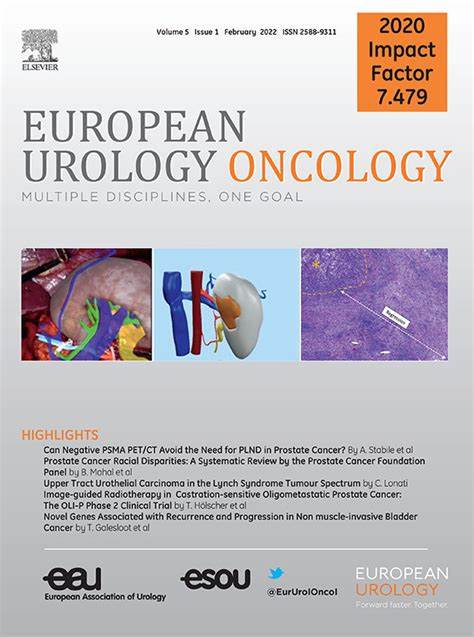Clinical Outcomes and Targeted Genomic Analysis of Renal Cell Carcinoma Brain Metastases Treated with Stereotactic Radiosurgery
IF 8.3
1区 医学
Q1 ONCOLOGY
引用次数: 0
Abstract
Background
Molecular profiles of renal cell carcinoma (RCC) brain metastases (BMs) are not well characterized. Effective management with locoregional therapies, including stereotactic radiosurgery (SRS), is critical as systemic therapy advancements have improved overall survival (OS).
Objective
To identify clinicogenomic features of RCC BMs treated with SRS in a large patient cohort.
Design, setting, and participants
A single-institution retrospective analysis was conducted of all RCC BM patients treated with SRS from January 1, 2010 to March 31, 2021.
Intervention
SRS for RCC BMs.
Outcome measurements and statistical analysis
Next-generation sequencing was performed to identify gene alterations more prevalent in BM patients. Clinical factors and genes altered in ≥10% of samples were assessed per patient using Cox proportional hazards models and per individual BM using clustered competing risks regression with competing risk of death.
Results and limitations
Ninety-one RCC BM patients underwent SRS to 212 BMs, with a median follow-up of 38.8 mo for patients who survived. The median intracranial progression-free survival and OS were 7.8 (interquartile range [IQR] 5.7–11) and 21 (IQR 16–32) mo, respectively. Durable local control of 83% was achieved at 12 mo after SRS, and 59% of lesions initially meeting the radiographic criteria for progression at 3-mo evaluation would be considered to represent pseudoprogression at 6-mo evaluation. A comparison of genomic alterations at both the gene and the pathway level for BM+ patients compared with BM– patients revealed phosphoinositide 3-kinase (PI3K) pathway alterations to be more prevalent in BM+ patients (43% vs 16%, p = 0.001, q = 0.01), with the majority being PTEN alterations (17% vs 2.7%, p = 0.003, q = 0.041).
Conclusions
To our knowledge, this is the largest study investigating genomic profiles of RCC BMs and the only such study with annotated intracranial outcomes. SRS provides durable in-field local control of BMs. Recognizing post-SRS pseudoprogression is crucial to ensure appropriate management. The incidence of PI3K pathway alterations is more prevalent in BM+ patients than in BM– patients and warrants further investigation in a prospective setting.
Patient summary
We examined the outcomes of radiotherapy for the treatment of brain metastases in kidney cancer patients at a single large referral center. We found that radiation provides good control of brain tumors, and certain genetic mutations may be found more commonly in patients with brain metastasis.
立体定向放射手术治疗肾细胞癌脑转移瘤的临床疗效和靶向基因组分析
背景:肾细胞癌(RCC)脑转移瘤(BMs)的分子特征尚不十分明确。采用包括立体定向放射外科手术(SRS)在内的局部区域疗法进行有效治疗至关重要,因为系统疗法的进步提高了总生存率(OS):目的:在一个大型患者队列中确定接受SRS治疗的RCC骨髓瘤的临床基因组学特征:对2010年1月1日至2021年3月31日期间接受SRS治疗的所有RCC BM患者进行单一机构回顾性分析:干预措施:SRS治疗RCC骨髓瘤:结果测量和统计分析:进行了新一代测序,以确定在BM患者中更为普遍的基因改变。使用Cox比例危险模型对每位患者的临床因素和≥10%样本中发生改变的基因进行评估,并使用带有死亡竞争风险的聚类竞争风险回归对每个BM进行评估:91名RCC骨髓瘤患者接受了212个骨髓瘤的SRS治疗,存活患者的中位随访时间为38.8个月。颅内无进展生存期和OS的中位数分别为7.8个月(四分位间距[IQR] 5.7-11)和21个月(IQR 16-32)。SRS术后12个月时,83%的病灶得到了持久的局部控制,59%的病灶在3个月评估时初步符合放射学进展标准,但在6个月评估时被认为是假性进展。通过比较BM+患者与BM-患者基因组和通路水平的改变,发现磷酸肌酸3-激酶(PI3K)通路改变在BM+患者中更为普遍(43% vs 16%,p = 0.001,q = 0.01),其中大部分是PTEN改变(17% vs 2.7%,p = 0.003,q = 0.041):据我们所知,这是调查 RCC BMs 基因组特征的最大规模研究,也是唯一一项有颅内结果注释的此类研究。SRS可对BMs进行持久的场内局部控制。识别 SRS 后假性进展对于确保适当的治疗至关重要。PI3K通路改变在BM+患者中的发生率高于BM-患者,值得在前瞻性环境中进一步研究。患者总结:我们在一家大型转诊中心研究了肾癌患者脑转移放疗的治疗效果。我们发现放射治疗能很好地控制脑肿瘤,而且某些基因突变可能在脑转移患者中更为常见。
本文章由计算机程序翻译,如有差异,请以英文原文为准。
求助全文
约1分钟内获得全文
求助全文
来源期刊

European urology oncology
Multiple-
CiteScore
15.50
自引率
2.40%
发文量
128
审稿时长
20 days
期刊介绍:
Journal Name: European Urology Oncology
Affiliation: Official Journal of the European Association of Urology
Focus:
First official publication of the EAU fully devoted to the study of genitourinary malignancies
Aims to deliver high-quality research
Content:
Includes original articles, opinion piece editorials, and invited reviews
Covers clinical, basic, and translational research
Publication Frequency: Six times a year in electronic format
 求助内容:
求助内容: 应助结果提醒方式:
应助结果提醒方式:


